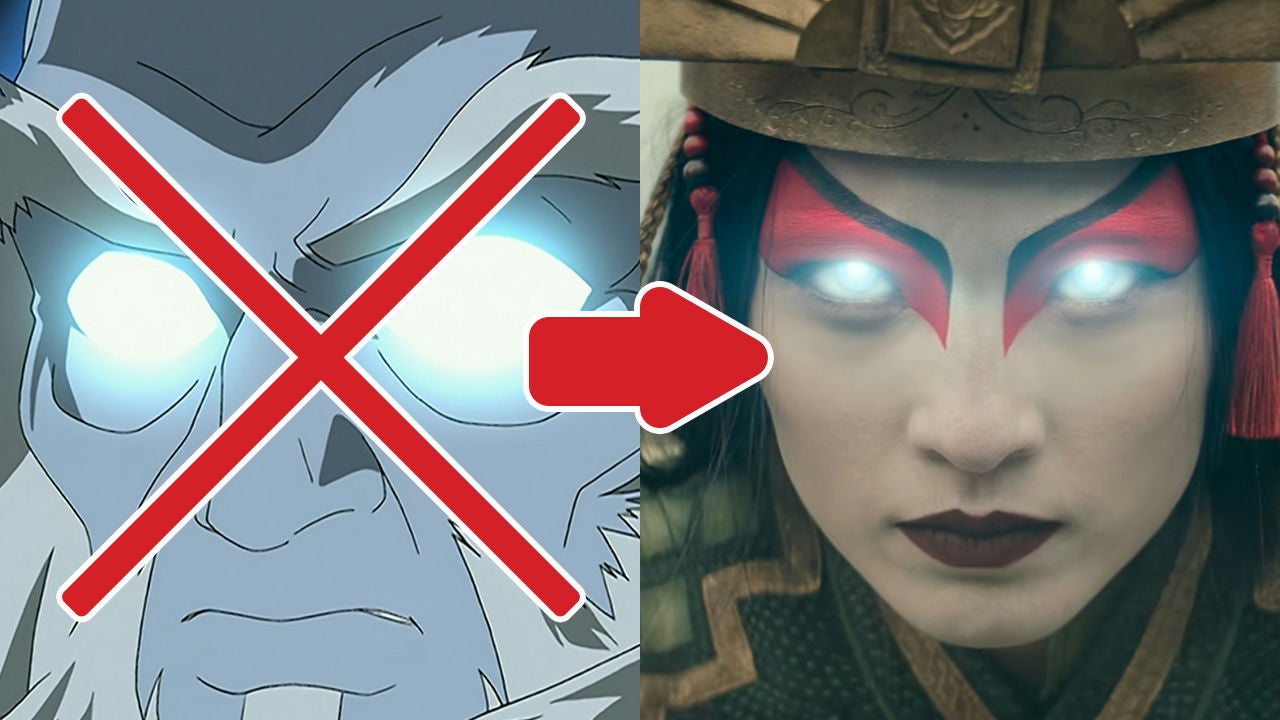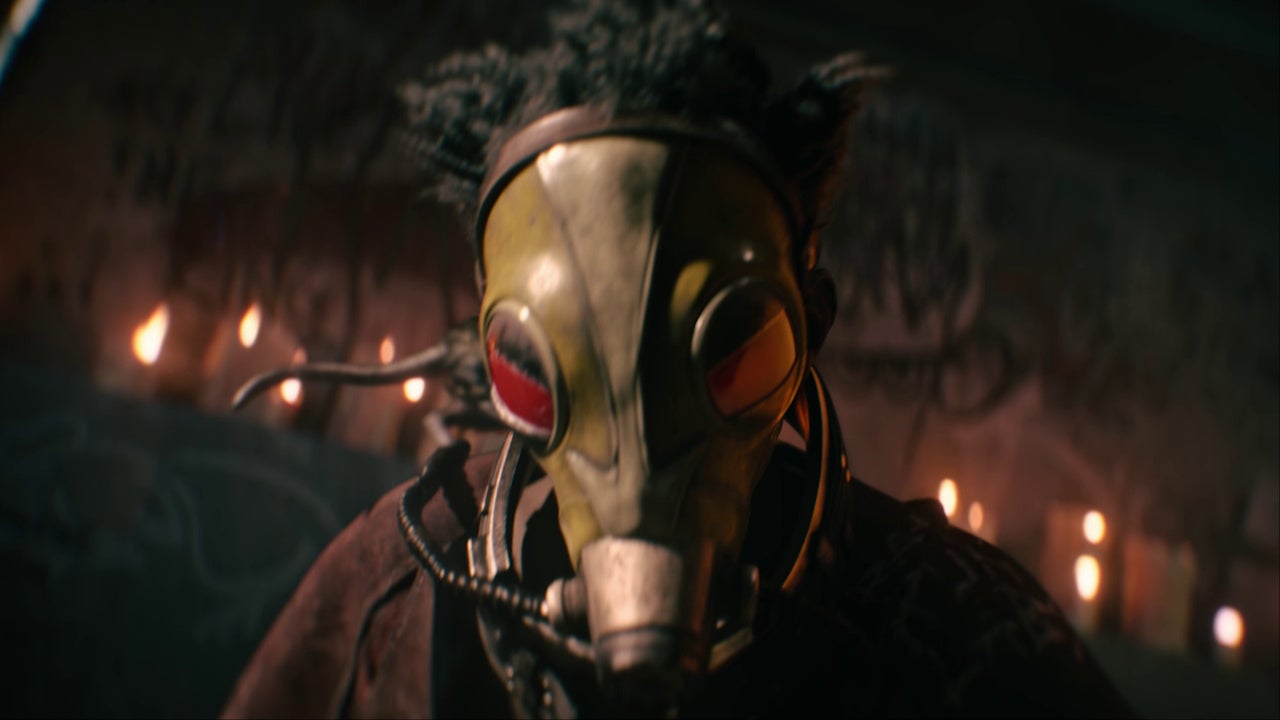Warning: This article contains spoilers for Avatar: The Last Airbender. If you haven’t watched the Netflix adaptation just yet, check out our spoiler-free review of the Avatar: The Last Airbender series.
The new Avatar: The Last Airbender series on Netflix brings the adventures of Aang (Gordon Cormier), Katara (Kiawentiio) and Sokka (Ian Ousley) into live-action (again), but as is the case with any adaptation, some key changes were made in the transition. We’re going to compare the original animated series with the Netflix show and run through the biggest differences that were made to the Book One: Water storyline, from action-packed flashbacks to new rules for the Avatar State.
Changes in Episode 1 - “Aang”
Earthbender Blitz

The original Last Airbender series started at the South Pole with Katara and Sokka discovering a frozen Aang, but the Netflix show starts on a far different note. It begins 100 years before the events of the original show, as an unnamed Earthbender soldier desperately tries to fight his way out of the Fire Nation capital with what he believes are Fire Lord Sozin’s secret plans to attack the Earth Kingdom. Though he was successful in extracting the plans, he’s horrified to learn that Sozin wanted his strategy to leak to create a diversion while he launches a surprise attack on the Air Nomads.
The Genocide of the Air Nomads

The cartoon often alluded to the genocide of the Air Nomads, but never actually showed it. The live-action series shows the entire tragic event. We watch as Fire Lord Sozin and his soldiers, supercharged by the fiery comet overhead, attack the Air Nomads in the dead of night. Another new wrinkle is the comet festival that brought all of the Air Nomads together in one spot, so Sozin is able to wipe all of them out in one fell swoop, save for Aang. In the original, Aang already knows he’s the Avatar and runs away when he learns it’s time to leave home to begin training, whereas in the Netflix show Monk Gyatso tells Aang he’s the Avatar and he goes for a ride on Appa to process the big news. Showing Aang’s life before the time-jump gives us a look at Aang’s relationship with Monk Gyatso firsthand and exactly how the Fire Nation came to power.
Aang Steals Zuko’s Avatar Notebook

When Aang breaks out of his cell on the Fire Nation ship, he sneaks into Zuko’s quarters and finds a notebook filled with meticulous research on the various past Avatars. Aang steals the notebook and uses it throughout his journey to learn more about the Avatars and the locations of their shrines. Really, it’s lucky for Aang that Zuko was banished and spent years obsessively cataloging everything about the Avatar! In the original, that information tends to be communicated to Aang when visiting the Spirit World. Later in the Netflix show, when the two characters are hiding from Zhao’s soldiers, the notebook plays a secondary role in helping Aang make a personal connection with Zuko.
Aang’s Emotional Anchor

At the end of the first episode, the trio visits the ruins of the Southern Air Temple. Aang is so distraught and overcome with sadness over the loss of the Air Nomads that he begins to involuntarily channel the destructive power of the Avatar State. When this happens in episode three of the cartoon, “The Southern Air Temple,” Katara helps Aang snap out of it by sharing her own personal story of loss and telling him that she and Sokka are his family now. In the Netflix show, it’s Aang’s memory of the kind-hearted Gyatso that brings him back to earth. It seems this was done because at that point in the story the characters hadn’t bonded enough for them to be a family, and Katara’s emotional plea to Aang is saved for the Season 1 finale to return him to normal after becoming Koizilla.
Changes in Episode 2 - “Warriors”
Katara’s Waterbending Scroll

In the original show, Katara steals a scroll teaching Waterbending techniques from pirates. In the live-action version, Katara finds the techniques in her bag alongside a note from Gran Gran. This change gives Katara an extra connection to home and her heritage, as Gran Gran is not only giving her approval for Katara to become a Waterbender but passing on a special piece of their family history.
Sokka the Warrior

In the animated series, Sokka starts off blatantly sexist, literally saying, “There’s no way a bunch of girls took us down!” when the team is captured by the Kyoshi Warriors. It’s only after spending time with Suki and training as a Kyoshi Warrior himself (including the ceremonial makeup and dress uniform) that he starts to learn proper respect for women. In the Netflix show, Sokka’s arc focuses instead on his desire to be the warrior his father Hakoda expected him to be, and all the pressure that comes with it. His insecurities about whether he can be a great warrior are laid bare when Suki repeatedly out-does him in everything from target practice to hand-to-hand combat, which leads to a different kind of arc about living up to expectations and finding your own path.
Suki’s Mother

Suki’s mother Yukari is a new character added for the Netflix show, played by Tamlyn Tomita.
New Rule for the Avatar State

In the original, the first Avatar Aang meets and communes with is Avatar Roku. In the Netflix adaptation, Avatar Kyoshi is Aang’s first connection to that part of himself, and the meeting comes much earlier in the story.
This meeting adds a new rule to the Avatar State, giving Aang the ability to give himself over to past Avatars so they can unleash the power of all four elements when needed. However, Aang can only unlock this ability and commune with the other Avatars when he is physically at their shrines. Much is said about the importance of the Avatar’s power, but it’s not until Avatar Kyoshi’s display of that power — wielding all four elements against the Fire Nation — that shows first-hand why the Avatar is such a big deal.
Another new part of Aang’s meeting with Kyoshi is the vision she gives him of the Fire Nation’s impending attack on the Northern Water Tribe. Prophecy isn’t a part of the Avatar’s power kit in the original, but here it works to set the stakes and give Aang his primary objective for Season 1.
Aang Doesn’t Learn Waterbending

The first season of the animated series is titled Book One: Water and sees Aang learn his first new element, Waterbending, with some tutoring from Katara. But in the adaptation, Aang doesn’t learn to Waterbend. He is pretty good at splashing, though.
Aang’s Signature Move

The opening sequence of the animated series features a silly moment where Aang accidentally runs head-first into a pillar while riding his signature air scooter. This moment is recreated in an actual episode of the Netflix series while Katara is talking him up.
Commander Zhao’s Secret Helper

In the original, Azula is merely teased at the end of the first season and doesn’t become a main character until Season 2. In the Netflix show, Azula plays a key role throughout the season by helping out Commander Zhao from afar. After Zhao sends a letter to Fire Lord Ozai to feed him information about Zuko, Azula sneakily takes up the correspondence with Zhao without her father’s knowledge. Throughout the rest of the season, Azula secretly provides Zhao with valuable intel and Fire Nation resources.
Changes in Episodes 3 and 4 - “Omashu” and “Into the Dark”
Azula’s Duplicitous Debut

A new scene introducing Azula sees her infiltrating a group of rebels planning to assassinate Fire Lord Ozai. When the rebels break into the throne room, Azula reveals her true identity and it’s made clear she has led them to their deaths. She looks on in euphoria as her father roasts the intruders alive. That’s certainly one way to get her manipulative, sadistic character qualities across!
The New Omashu Players

Netflix’s two-part Omashu arc is made up of a few different episodes from the original series. The main story is still about Aang reconnecting with his old friend Bumi, but interwoven with it are the stories about Jet and the Freedom Fighters and Teo and his father the Mechanist. Though these three stories happen at different times in the original, they all share the theme of regular people dealing with the Fire Nation’s oppression, which is how the adaptation brings them together into one arc.
Zuko vs. Aang in Omashu

Originally, Zuko and Iroh aren’t a part of the Omashu arc, but here Zuko battles Aang in the market and Iroh draws the guards’ attention his way, allowing himself to be captured so Zuko can escape.
Iroh’s Earthbender Confrontation

In the original, the Earth Kingdom soldiers do confront Iroh about the Fire Nation’s 600-day siege of Earth Kingdom city Ba Sing Se, but in the adaptation it gets much more intense as one soldier abuses Iroh, the two argue and share the bitter losses they personally endured in the battle, and the enraged Earthbender almost crushes Iroh with a boulder.
The Cave of Two Siblings

The iconic “Secret Tunnel” song from the original starts out with new lyrics, heard when Katara and Sokka first encounter the group of traveling musicians:
When you find yourself in darkness
And all you see are rocks and stones
Remember that a precious gift must bury deep inside
So dig a bit and you will find
Jewel of my heart
The secret tunnel sequence originally happened in Season 2 in the episode titled "The Cave of Two Lovers" and Aang was a part of the group, which very awkwardly led to Aang and Katara having to kiss as a gesture of love to gain the loyalty of the badgermoles. In the Netflix series, Aang is off fighting Bumi, so in a new twist, Katara and Sokka hold hands in an expression of their familial love to gain the creature’s trust.
Flashbacks for Zuko and Iroh

The live-action show adds in two flashbacks to further flesh out Zuko and Iroh’s relationship. One sees Zuko comforting Iroh at his son’s funeral, while the other shows when Iroh joined Zuko on his quest to find the Avatar.
During the funeral scene, we hear an orchestral version of “Leaves From the Vine (Little Soldier Boy)” which is the song Iroh sang to memorialize his son in the cartoon.
Team Avatar vs. King Bumi

In the original series, Katara and Sokka are in peril during Aang’s fight with King Bumi, trapped in slowly growing green crystals that threaten to snuff them out, whereas in the Netflix show they arrive in the nick of time at the end of the fight to help Aang deal with Bumi.
Changes in Episodes 5 and 6 - “Spirited Away” and “Masks”
Ozai’s Game of Thrones

Throughout the season, we watch Ozai play Azula and Zuko against each other. In Episode 5, we see Azula trying to claim credit for the discovery of the Avatar, but Ozai reminds her it was Zuko who found him. He berates his daughter for her “self flattery and coy whispers” and sends her off with tears welling in her eyes.
Blue Spirited Away

The two-part story that takes place over “Spirited Away” and “Masks” combines a few different episodes from the animated series. The destroyed forest, missing villagers, and Hei Bai come from "Winter Solstice, Part 1: The Spirit World.” The evil spirit Koh the Face-Stealer and Aang communicating with Avatar Roku comes from "The Siege of the North, Part 1.” And Aang being imprisoned by Zhao and later rescued by a disguised Zuko comes from “The Blue Spirit.”
The two-part story that takes place over “Spirited Away” and “Masks” combines a few different episodes from the animated series. In the animated episode "Winter Solstice, Part 1: The Spirit World,” only Sokka is trapped in the Spirit World by the Hei Bai, but in the adaptation both Sokka and Katara are stuck, this time thanks to Koh. While captured, they both revisit traumatic moments from their pasts, giving us deeper insight into their backstories.
In the animated episode "The Siege of the North, Part 1,” Aang goes to the Spirit World to learn the location of the moon and ocean spirits from Koh, whereas in the new version Aang wants Koh to free his friends and learns that the evil spirit wants a special figure that was taken by Avatar Roku. In the cartoon, Aang saves Sokka and the villagers by calming down the Hei Bai, which ends up being a giant panda spirit, by giving him the acorn promising new growth of the forest, not unlike how Katara comforts Aang when he’s saddened by the burnt-down forest in the Netflix show.
In the animated episode “The Blue Spirit,” Aang goes on a mission to find medicine for Katara and Sokka after they become ill, and that’s when he’s captured by the Yuyan Archers on order of Commander Zhao. In the new version, Aang needs to find a way to appease Koh before his friends are trapped in the Spirit World forever, and it’s June who captures Aang by order of Zuko and Iroh, only for Zhao to take Aang from them. The Yuyan Archers are still utilized by Zhao but not until the Blue Spirit tries to rescue Aang.
The spirit owl Wan Shi Tong that advises Aang in the live-action version originally appeared in the animated episode “The Library.”
Aang’s reunion with Monk Gyatso in the Spirit World is a new addition to the story for the Netflix version. Monk Gyato is given more prominence in the Netflix version, acting as a link to Aang’s prior life and as the main figure around which he learns to process grief, so this new appearance is added as a bookend to Aang’s attempt to find closure.
A Fiery Flashback

In the cartoon, we don’t witness the full story behind Zuko’s banishment, but the Netflix version shows everything. We see how it was Zuko’s questioning of his father’s military plan to sacrifice the 41st division that led to Ozai demanding he settle the matter with an Agni Kai ceremonial duel, as well as Ozai’s merciless fight with Zuko and the horrifying moment he scarred his son’s face. Originally, Zuko refused to fight at all. But, in the live-action version he eventually battles his father only to ultimately show mercy in the final moments, which only makes dad even more angry. It’s also of note that we see Ozai’s immensely powerful Firebending skills early in the story, rather than waiting until the series finale.
After the fight, we’re shown Ozai banishing Zuko. This scene adds in new conditions for the prince’s banishment, removing Zuko’s place as heir to the throne and forcing him to take the 41st Division with him. In the present, Iroh reveals to new character Lieutenant Jee that Zuko saved his life along with the entire 41st division, which gives them a newfound respect for their prince.
Changes in Episode 7 - “The North”
Azula Defies Daddy

The animated series episode “The Avatar State,” shows Azula aboard her ship practicing lightning bending and receiving criticism from her trainers for not being completely perfect. This Season 2 scene is similar to how in the Netflix version, Ozai supervises her training as she beats up an Earth Kingdom prisoner. But, even though she won, Azula is unfairly criticized for not winning as fast as she could have. Later, she refuses to keep playing daddy’s game and shows off her powerful new Lightning generation skill, which is finally enough to impress Ozai and give her the opportunity to prove herself in the field.
Changes in Episode 8 - “Legends”
Women of the Northern Water Tribe, Assemble

Just like in the original series, Waterbending Master Pakku of the Northern Water Tribe stubbornly insists that women aren’t allowed to fight, owing to the tribe’s sexist “traditions. In the Netflix version, when Katara stands up to Pakku and joins the final battle, there’s a new, empowering moment where the other female Waterbenders stand up with her, which finally convinces Pakku to change his mind. One key detail not mentioned in the live-action version is how Pakku was at one time arranged to marry Katara’s grandmother Kanna, aka Gran Gran, but Pakku’s strict adherence to his misogynistic ideals drove her away and she left to live with the Southern Water Tribe instead.
Don’t You Go, Momo

In the original series, Princess Yue brings Team Avatar to the Spirit Oasis so Aang can better commune with the Spirit World, whereas in the new version Momo is injured in the battle and Yue has Sokka bring him to the Spirit Oasis because its waters have healing properties.
Speaking of those healing waters, later on when Pakku gives Katara the amulet filled with water from the Spirit Oasis, he doesn't mention the healing properties like he did in the cartoon, but we figure she'll get the gist when Sokka shares what happened to Momo.
Zuko vs. Katara

Much of the staging of the season finale is different between the cartoon and the live-action version, although the main beats are largely the same. In the cartoon, Zuko kidnaps Aang’s body while he’s in the Spirit World dealing with Koh and he must be saved by Katara and Sokka. Meanwhile, the Netflix version skips the Spirit World part, having already covered that material earlier in the season. Because of this change, Aang is able to join Sokka and Yue in the Spirit Oasis thanks to Katara holding off Zuko. In the Netflix version their battle is interrupted by an explosion, whereas the cartoon sees Zuko defeat Katara and kidnap Aang, only for Katara to later catch up and take out Zuko in seconds.
Zhao’s Final Fate

In the animated series, a defeated Zhao is grabbed by the Ocean elemental. Zuko tries to save him, but Zhao is unable to swallow his pride and instead resigns himself to his fate as the spirit drowns him. In the Netflix version, Zhao is beaten by Zuko and uses his last words to deliver an emotional gut punch that wasn’t in the original. He reveals to Zuko that his father never intended for Zuko to ever return from his banishment and that he was only using Zuko as a tool to help hone his true chosen heir, Azula. Zhao reveals that it was Azula who was helping him all along, which explains how he knew Zuko was the Blue Spirit and why he was sent the elite Yuyan Archers. Instead of meeting his end at the watery hands of Koi-zilla, Zhao tries to sucker punch Zuko but is stopped, for good, by a deadly fire blast from Iroh.
It’s of note that while Zhao played a similar role throughout the season in the original as a foil to Zuko, in the live-action version he’s much more sneaky, duplicitous, and ambitious.
Aang’s New Anchor

In the cartoon, the ocean spirit simply releases control of Aang when the moon spirit is restored, but in the Netflix version it takes Katara’s emotional plea to free him from its possession. Whereas the father-like Monk Gyatso was Aang’s anchor in the first episode of the Netflix series, now it’s Aang’s new friends that help bring him back. This shows how even though Aang did suffer an incredible loss, he’s now found a new family in Team Avatar.
Azula’s First Conquest

The season ends with Azula taking Omashu. The city does fall to the Fire Nation in the original, but it doesn’t happen until the second season and it wasn’t Azula’s conquest. Moving that moment up and giving it to Azula better sets her up as the next villain for Team Avatar to face.
That's everything different we noticed in Netflix's live-action Avatar: The Last Airbender series. Let us know anything you spotted in the comments.






